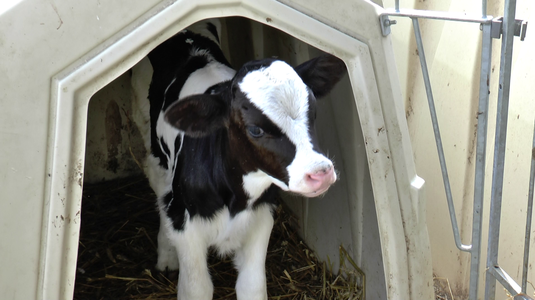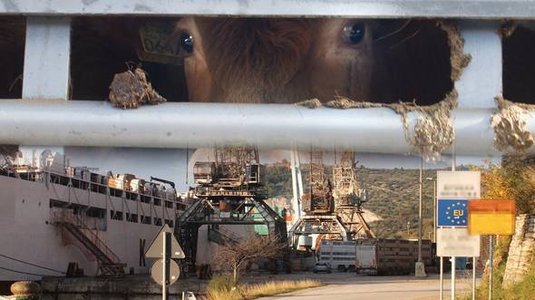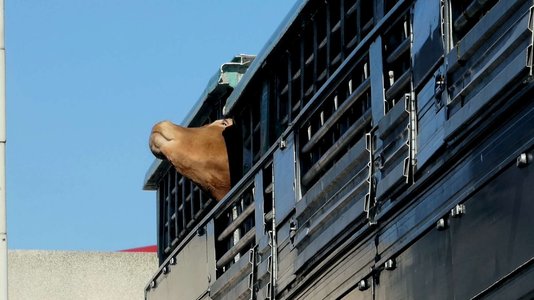Dossiers
Long-distance transports of lambs
1. Introduction
This dossier focuses on transports of lambs1 from Hungary, Romania and Poland to Italy, documented between 2016 and 2019 by teams of AWF|TSB (Animal Welfare Foundation, AWF, based in Germany and Tierschutzbund Zürich, TSB, based in Switzerland) with support from Animal Equality Italy, Ente Nazionale Protenzione Animali (ENPA) and Guardia Zoofila in 2018 and 2019. The main focus is on the transport of lambs which are slaughtered in Italy for Easter and Christmas celebrations. In total 17 transports of lambs were documented in detail, in most of the cases with serious infringements of the Council Regulation (EC) No 1/2005 of 22 December 2004 on the protection of animals during transport. The dossier brings together all infringements of the Regulation (EC) No 1/2005 documented by AWF|TSB during investigations of transports of lambs to Italy. It shows that the main infringements are mostly related to the fact that the loading densities are much too high comparing to the requirements, and that some animals transported are very young, so young that they cannot be supplied according to their needs on long-distance transports. In addition, the dossier shows that several companies repeatedly transport lambs in a way that is a breach of the Regulation (EC) No 1/2005, in some cases even despite numerous police controls and fines. This unacceptable practice can be explained by the lack of enforcement of Regulation (EC) No 1/2005 by the authorities in the member states of departure and destination. Additionally, the penalties applied (both police fines and official complaints) have not been effective, proportionate and dissuasive and therefore have not led to significant improvements of enforcement of the Regulation (EC) No 1/2005.
2. Background Information
In Italy, lamb is a delicacy and not only at Easter, but also at Christmas a main part of many festive meals. However, what is often hidden is that, until the lambs are slaughtered in Italy, they often are transported for days in unsuitable vehicles in unacceptable conditions. Although Italy itself has more than seven million sheep, Italy is not self-sufficient in terms of demand for lamb meat.
In 2018, Italy imported 901,046 lambs for slaughter. Out of this number, more than 150,000 were imported for slaughter short before Christmas, and more than 200,000 before Easter. Most of the lambs came from Hungary (476,359), Romania (336,734), France, Bulgaria and Spain. Poland, where three transports documented by AWF|TSB originated, exported approx. 13,000 lambs to Italy in 2018. In addition to that, Italy imported 72,706 sheep in 2018, with a peak in March (17,637, majority from Romania).
In total, each year more than three million sheep are transported within the EU, out of which more than two million are intended for direct slaughter, and almost one million for fattening (i.e. later also for slaughter). Italy imports approximately 40% of all sheep intended for slaughter in the EU. Out of this, young animals (less than one year old) are the majority of animals transported to Italy for slaughter (85% in 2016).
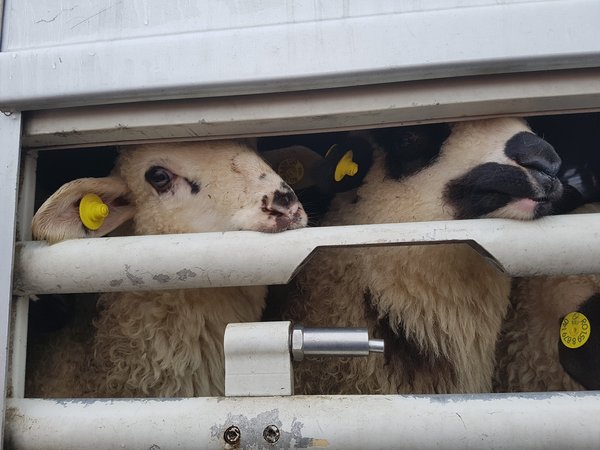
For the animals, transport means stress of unfamiliar environment, noises and vibrations, being mixed with unknown animals, reduced ability to move, as well as restricted access to food and water, among other things.
Some of the transported lambs are not even weaned when transported for slaughter to Italy. This means they still rely on a milk diet. However, milk replacers cannot be provided on the vehicles. In various cases, AWF|TSB documented road vehicles full of young lambs, which were bleating during the whole journey, which indicates stress, and in most cases hunger and thirst. In particular before Easter, many unweaned animals are transported for slaughter. According to the documents, numerous the lambs are indicated as two months old; however, according to veterinarians of AWF|TSB, in several cases the animals were likely even younger.
Besides the problems related to the transport of unweaned lambs, various other infringements of the Regulation (EC) No 1/2005 causing undue suffering to the animals were documented. Infringements are frequently related to the planning of the transports, the available space for the animals and the arrangements to meet animals’ needs as regards rest, feed and water. Furthermore, the vehicles used are often inappropriate for the transport of lambs. In addition to that, infringements related to the documentation and traceability of transports were frequently found; such infringements also have an essential impact on the welfare of transported animals.
3. Findings from our investigations (2016-2019)
In the following chapter, the main problems documented by AWF|TSB in long-distance transports of lambs to Italy are listed. In addition, the articles of the Regulation (EC) 1/2005 which were violated are added, as well as a brief description of the animal welfare problems and recommendations of improvements. The recommendations are based on the Regulation (EC) No 1/2005, as well as on scientific studies and letters of the European Commission. Several recommendations also refer to the “Guide to good practices for the transport of sheep”11, which has been published within the framework of a DG Sante project of the European Commission.
Main infringements and welfare implications:
The analysis of the data gathered during inspections of 17 lamb transports together with police and official veterinarians in Italy shows that the following problems observed in transports of lambs to slaughterhouses in Italy are the main ones negatively affecting the welfare of lambs on board of road vehicles:
- Drinking devices inadequate for lambs, restricted access to water or lack of it
- Not enough feed stuff on board
- Inadequate bedding
- Insufficient space for the lambs (floor area and headspace)
- Non-separation of animals of different sizes and/or with and without horns
- Exceeded maximum journey times
- No inspection of welfare conditions
- Transport of unfit/downer lambs
- Inadequate vehicle design
- Dangerous partitions
- Faulty documentation
- Transport of unweaned lambs without special arrangements (road transport vehicles not equipped with watering system suitable for this category of transported animals)
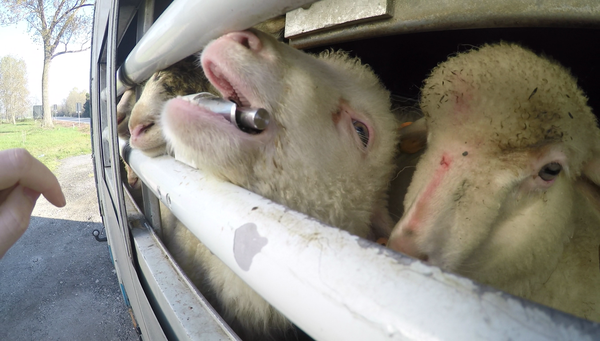
In addition to the above-mentioned violations, in various cases infringements of social regulations, e.g. related to the drivers’ driving times were detected. Such infringements also have to be mentioned here with regard to animal welfare since e.g. drivers which are totally overtired are neither in a position to drive carefully in order to avoid injuries of the animals, nor are they able to properly take care of the animals on board of the road vehicles.
A large share of this suffering is caused by the fact that the animals are loaded on four decks instead of on three decks only. While it would be important to transport lower numbers of animals on only three decks of a road vehicle, the economic incentive to load as many animals as possible on one road vehicle is put before the welfare of the transported animals.
According to the assessment of AWF|TSB, the problems observed in transports of lambs on the route to Italy are not incidental in nature, but regular, since the infringements were observed in every inspected road vehicle. In case of inspections with the police and official veterinary authorities in Italy, the infringements of the Regulation (EC) No 1/2005 were officially confirmed and fines for the breaches were imposed, also regarding violations of drivers’ social regulations.
One of main concerns of AWF|TSB besides direct animal welfare problems, is the fact that despite inspections performed by authorities and fines imposed by them, repetitions of various violations of the Regulation (EC) No 1/2005 by the same transporter companies were observed in the course of four years of investigations, and no measures have been taken by these or other competent authorities to solve the problem efficiently.
4. Summary and Conclusion
4.1 Responsibilities and failures on various levels
Besides the fines imposed by the police, AWF|TSB sent letters of complaint and information to the National Contact Points of the European countries involved in the trade of lambs. In addition, the European Commission has been informed about the regular violation of the Regulation (EC) No 1/2005 during the transport of lambs for slaughter. However, until today, the conditions of lambs transported for slaughter remain poor and improvements of animal welfare are urgently needed.
The violations of the Regulation (EC) No 1/2005 occur at different levels under the responsibility of different parties. The infringements are related to the planning of journeys and their approval, as well as the approval of inappropriate vehicles for the long-distance transport of lambs. In addition, infringements are related to loading and transport conditions, i.e. the direct handling of the animals, for which keepers, transporters and attendant/drivers12 are responsible. Furthermore, transporters and transport organizers are responsible for the welfare of the transported lambs during the whole journey.
Problems at the stage of approval of vehicles and long journeys are also confirmed by the results of an audit carried out in Hungary by the Directorate-General for Health and Food Safety of the European Commission in 2017 (European Commission, DG(SANTE) 2017-6099): “The poor standard for approval leads to a risk of inadequate space allowances and unsuitable drinking devices, during long journeys and thus to welfare problems for the animals transported. The inadequate measuring of deck floor surface areas and assessment of drinking devices at the time of approving the vehicle leads to incorrect calculations on stocking densities – as they are based on the deck surface area indicated in the vehicle approval certificate.”
Furthermore, according to the observation of AWF|TSB, the suffering of animals is related to the fact that certificates of vehicle approval are issued for vehicles which are not even appropriately designed for the species. Besides inadequate drinking devices, this includes a lack of lateral protection on the floor (and thus lambs’ legs can easily get trapped between the floor and the wall), as well as lack of doors to access the animals. Such factors can easily be checked when approving the vehicle and the transport.
Many problems are also related to the direct handling of the lambs, like the loading or unloading of animals, taking care of injured animals or providing adequate rest and bedding, feed and water to them. To this end, attendant/drivers are needed, who are trained and have experience in handling the transported species and category of animals.

The main responsibility regarding the transport lies in the hands of the transport organiser and the transporter. However, as pointed out above, documentations of AWF|TSB show that in many cases economic considerations seem to play a larger role than the welfare of the animals from which the transporters profit.
The fact that neither police fines, nor official complaints have led to significant improvements, shows that there is a general problem of enforcement of the Regulation (EC) No 1/2005 and that Article 25 (Penalties) is not being complied with:
“The Member States shall lay down the rules on penalties applicable to infringements of the provisions of this Regulation and shall take all measures necessary to ensure that they are implemented. The penalties provided for must be effective, proportionate and dissuasive”.
The problems in this regard start with the fact that the authorities at the place of destination frequently do not inform the competent authorities at the place of departure about infringements found, and they continue with the failure to implement measures to remedy the breaches or prevent the recurrence of infringements according to Article 26 (Infringements and notification of infringements).
The lack of notifications between the member state of destination and the member state of departure contributes clearly to the situation of non-enforcement of the Regulation. Hence, authorities need to take the enforcement of the Regulation (EC) No 1/2005, as well as the protection of animals during transport –the actual goal of the Regulation – seriously. In addition, more inspectors are needed, and fines imposed should be related to the additional profit gained by breaking of the law and should constitute a noticeable loss for the organizers and transport companies.
In the resolution of February 14, 2019 on the implementation of Council Regulation (EC) No 1/2005 on the protection of animals during transport, the European Parliament calls on the European Commission to shift from transporting live animals to the transport of meat and carcasses. Until this call is put into practice and makes long-distance transports obsolete, AWF|TSB will continue to work on improving the conditions of transported animals, among other things, on improving the welfare of lambs transported over long distances to slaughterhouses in Italy.
AWF|TSB rejects long-distance transports of unweaned lambs (transports of more than 8 hours). We demand that unweaned lambs may only be transported over short distances within the EU.
The full dossier on the long distance transport of lambs consists of 31 pages. On request, the full dossier can be made available to competent authorities, veterinarians and media representatives.
